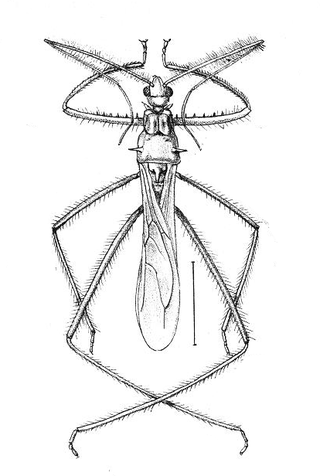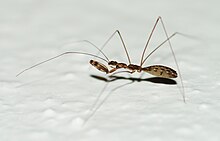
The Emesinae, or thread-legged bugs, are a subfamily of the Reduviidae. They are conspicuously different from the other reduviids by their very slender body form. They are stalking, predatory insects that can be collected on palm fronds, cliffs, spider webbing, or near lights at night. They walk on their mid and hind legs; the front pair is raptorial. Some groups specialize on spiders. Very little is known about emesines except that many species are found in the tropics. Pedro Wygodzinsky wrote the most recent revision of this group.
Ghilianella is a genus of true bug in the subfamily Emesinae. Fifty-eight species have been described, with a distribution from Guatemala to Brazil. The linear form of the species in this genus allow the young larvae to be carried about by the mother or perhaps the father. The larvae of the young can curl around the parent's thorax.

Stenolemus is a genus of thread-legged bug (Emesinae). Species of this genus are noted for preying on spiders.
Gardena is a genus of thread-legged bugs in the subfamily Emesinae. It is the second-largest genus in the tribe Emesini. Presently there are 46 described species.

Ploiariolini is a tribe of thread-legged bugs, comprising 16 genera and 142 described species. Ploiariolini has a worldwide distribution.

Emesopsis is a genus of tropical bugs (Heteroptera) from the family Reduviidae. There are at least 22 described species, of which one, E. nubila, also occurs in southern Europe.
Bagauda is a genus of thread-legged bug in the Emesinae. 18 species are currently known. Many of the species of this genus are associated with caves, some exclusively so. Bagauda is synonymous with the genus Pleias Kirkaldy, 1901, but Bagauda has become more widely used. The genus is restricted to Old World tropics.
Chinemesa is a little-known genus of thread-legged bug (Emesinae) apparently endemic to Borneo. Only four species have been described and the three described by Wygodzinsky in 1966 have not been observed since.
Polauchenia is a genus of thread-legged bug (Emesinae). Only five species have been described.

Empicoris is a cosmopolitan genus of thread-legged bug (Emesinae). Numerous species have been described.

Barce is a genus of thread-legged bugs in the family Reduviidae. There are about six described species in Barce.
Onychomesa is a little-known genus of thread-legged bug in the subfamily Emesinae. Three species have been described, one from India, Japan, and Taiwan.
The Collartidini is a tribe of thread-legged bugs restricted to Africa, Sri Lanka and Taiwan. Wygodzinsky (1966) proposed that this group is the sister group of the remaining Emesinae.

Sphedanolestes is a large genus of assassin bugs in the family (Reduviidae), subfamily Harpactorinae. There are more than 190 described species, which are found in southern Europe, Africa and Asia.
Emesa is a small genus of thread-legged bug (Emesinae). Only four species have been described.

Rhynocoris is a genus of assassin bug, family (Reduviidae), in the subfamily Harpactorinae. Species are recorded from Asia, mainland Europe, Africa and North America.

Saicinae is a subfamily of the family Reduviidae, or the assassin bugs.
Schidium is a large genus within the subfamily Emesinae, distributed in the Palaearctic, Afrotropical, Oriental, and Australian Regions.

LopodytesRondani 1867 is a genus in the family Reduviidae, the assassin bugs. Members of the genus have been unofficially assigned the common name grass assassin bugs, but generally this name remains meaningful only to naturalists, because these insects have been too well camouflaged to raise robust public awareness.

Oncerotrachelus is a genus of assassin bugs in the family Reduviidae. There are about 14 described species in Oncerotrachelus.











